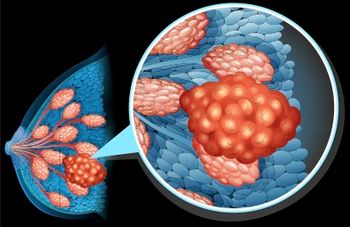
Oncology NEWS International
- Oncology NEWS International Vol 14 No 5
- Volume 14
- Issue 5
Sequential Chemo/Tam Improves Breast Cancer Survival
SAN ANTONIO-Long-term disease-free survival in node-positive, estrogen-receptor (ER)-positive postmenopausal breast cancer patients is improved when hormonal therapy follows chemotherapy, according to a 10-year analysis of the
SAN ANTONIOLong-term disease-free survival in node-positive, estrogen-receptor (ER)-positive postmenopausal breast cancer patients is improved when hormonal therapy follows chemotherapy, according to a 10-year analysis of the Breast Cancer Intergroup of North America Trial 0100, presented at the 27th Annual San Antonio Breast Cancer Symposium (abstract 37).
"In many cases, tamoxifen or other hormonal therapy alone is not optimal," said Kathy S. Albain, MD, of Loyola University Chicago Stritch School of Medicine, Maywood, Illinois. "This survival advantage is greatest when tamoxifen follows chemotherapy, rather than being given concurrently."
Dr. Albain performed a 10-year follow-up analysis of 1,477 patients enrolled in INT 0100. A total of 550 patients received concurrent chemohormonal therapy (CAFT) (cyclophosphamide, doxorubicin, fluorouracil, tamoxifen); another 566 patients received sequential chemohormonal therapy (CAF-T); and 361 patients received tamoxifen alone. Previous analyses showed superior survival in the combined CAF + T arms vs tamoxifen alone, and with CAF-T vs CAFT. The current study was the updated, mature outcomes analysis on the entire study population, with additional analyses of biomarkers to explore whether certain profiles can predict benefit from CAF.
Confirming the earlier findings, tamoxifen alone continued to be inferior to the combined CAF + T arms for both disease-free and overall survival, with adjusted hazard ratios of 1.31 and 1.21, respectively. Concurrent CAFT was worse than sequential CAF-T for both disease-free and overall survival (adjusted hazard ratios of 1.20 and 1.12, respectively).
Ten-year estimates of disease-free survival were 48% for tamoxifen alone; 53% for concurrent chemohormonal therapy; and 60% for sequential therapy. Ten-year overall survival estimates were 60%, 62%, and 68%, respectively.
The biomarker analysis contributed important new information from this study population, which Dr. Albain cautioned was hypothesis-generating and not yet ready for clinical use. From tissue available from 782 patients, information was obtained on ER level positivity using immunohistochemistry (IHC) by Allred score, mitotic and nuclear grade, HER2 status by IHC with Tab250 and CB11 or by FISH, and p53 expression.
In univariate analysis, significant adverse prognostic factors for disease-free survival were HER2-positivity by IHC Tab250, four or more positive nodes, larger tumor size, progesterone-receptor (PgR)-negative status, high mitotic grade, and p53 positivity. A particularly favorable prognostic group was women who were HER2 negative and PgR positive (P = .003), she said. Factors that were not significantly prognostic included ER positivity by various cutoffs, nuclear grade, and HER2 status by IHC CB11 or FISH.
Predictive factors for disease-free survival benefit from CAF (adjusted hazard ratio) included HER2 positivity by IHC Tab250 (54% improvement vs 22% with negative HER2 status); p53 positivity (56% vs 20% for p53 negative); high nuclear grade (48% for grade 3 vs 7% for grade 1-2); and low/intermediate ER score (score of 6-7) vs high ER score (score of 7-8) (44% improvement vs no benefit for high ER score). None of these tests was significant due to the small number of patients in the groups.
"We discovered that women with very high ER levels in their tumors can probably avoid chemotherapy," she said, "but those with low or intermediate levels benefit from it over and above tamoxifen."
High ER score was the only informative analysis in the prediction of a benefit from the timing of tamoxifen in the two CAF arms. Those with high ER levels had an improvement in disease-free survival with sequencing (CAF-T), compared with CAFT, she said. There was no added benefit to CAF vs tamoxifen alone in a favorable group with one to three positive nodes and HER2 negativity.
Articles in this issue
over 20 years ago
Nomogram Helps Predict Prostate Ca Metsover 20 years ago
Obesity Is Linked to Greater Prostate Cancer Death Ratesover 20 years ago
Three-Step Strategy Ups RRs in Poor-Risk Rectal CancerNewsletter
Stay up to date on recent advances in the multidisciplinary approach to cancer.


















































































